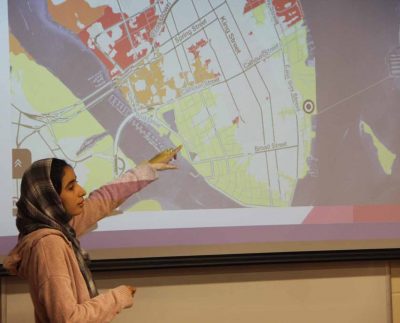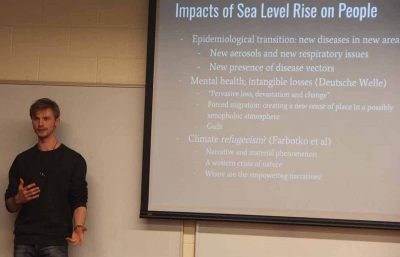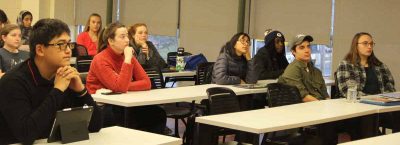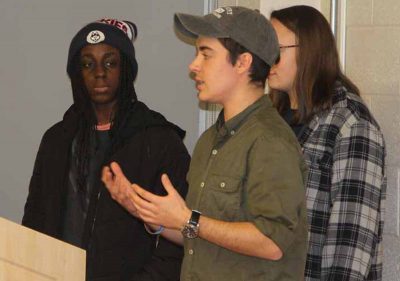
Story and photos by Judy Benson

Climate change is perhaps the biggest challenge humanity has ever faced, and just thinking about it can make someone feel exhausted and overwhelmed.
How can the next generation of environmental professionals be prepared to deal a problem that big?
One answer could be found this fall in the Climate Corps class taught at the University of Connecticut by Sea Grant’s Juliana Barrett and Bruce Hyde, land use academy director at UConn CLEAR (Center for Land Use Education & Research). Now in its second year, the course invites students to tackle this global challenge on local scales, methodically breaking it down into more manageable parts.
“We wanted to do a big project, so students could understand just how much sea level rise would cost in one community,” said Barrett, coastal habitat specialist and associate extension educator at Sea Grant. “This is a very different kind of assignment for kids, because there isn’t one right answer. It’s very gray.”
The culminating assignment she referred to, which the 24 students worked on throughout the semester, tasked them to work in teams to figure out how a four-foot rise in sea level would affect one of two communities – Miami Beach or Charleston, S.C. In the last weeks of class, the teams each did PowerPoint presentations showing the impacts on schools, hospitals, residential and commercial areas, including dollar calculations of the damage. They then had to find a place to relocate the entire population, and design a new community there that would address not only their physical and economic needs, but also the emotional and social trauma the climate refugees would experience.
“It was quite an extensive assignment,” said Amanda O’Lear, one of the students. “It seems like it’s almost insurmountable problem. We all came up with cost estimates in the billions of dollars.”

The team O’Lear worked determined nearly 20,000 residents of Miami Beach would be relocated inland, then had to find an undeveloped area and figure out the land and building costs. Nelson Durkee, another member of the team, said that while he sometimes found himself obsessing about how to solve various aspects of the challenge, he appreciated the chance to apply interdisciplinary skills in multi-faceted real-world context.
“Climate change is a really depressing issue,” he said. “But this actually gave me a lot of hope.”
Barrett said Miami Beach and Charleston were chosen for the assignment because they are two of the U.S. communities most vulnerable to rising seas. And while flooding and other impacts are likely to occur incrementally rather than all at once as the assignment dictated, the exercise is a valuable way for students to understand what’s at stake, she said.
“Even within their lifetimes, sea level rise let alone other aspects of climate change are going to be very costly, both in the primary and secondary impacts,” she said.

Sarah Schechter, who is majoring in environmental studies and anthropology, is among more than a dozen students in the class who plan to continue in the spring semester with a field experience portion of the class. She and other students will get a chance to work in Connecticut communities on issues such as road flooding and preparedness for storms that are becoming more frequent with climate change. A first-hand experience with an intense storm last summer in her neighborhood in Danbury, which topped dozens of trees and caused a death, heightened her awareness about the realities of climate change and the need for solutions.
“I’m getting a lot more real-world experience in this class than in other classes,” she said. “Climate change is an overwhelming problem, but it’s something that needs to be addressed.”
Barrett said she was particularly impressed with some of the new communities the students envisioned for the climate refuges. Several of the developments incorporated bicycle lanes, green roofs, rooftop gardens, renewable energy and other environmentally friendly elements that would also serve to help build a sense of community. One of the groups proposed housing families in repurposed shipping containers, borrowing an idea one of the team members saw on a visit to the Netherlands.
“I was so impressed by some of the solutions they came up with and their ideas of what those new communities might look like,” Barrett said.
The class, officially titled “Climate Resilience and Adaptation: Municipal Policy and Planning,” is supported by a grant from the UConn Provost’s Office.
Judy Benson is the communications coordinator at Connecticut Sea Grant.